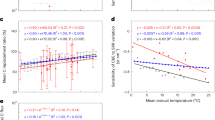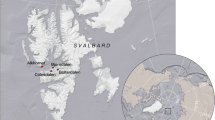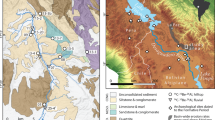Abstract
Soils play a central role in the global carbon cycle and constitute a key component of natural climate solutions that require quantitative predictions of soil organic carbon (SOC) dynamics at local to regional scales. In hilly and mountainous terrain, variations in uplift and stream incision generate gradients in erosion and hillslope morphology that control soil properties that impact the abundance and persistence of SOC. Here we use topographic and soil biogeochemical analyses to show that across 16 sites in our study region, total SOC stocks and the typically slower-cycling mineral-associated fraction of SOC decrease exponentially with modelled erosion rate from 21.0 to 0.2 kg m–2 and 12.0 to 0.1 kg m–2, respectively. Along the greater than order-of-magnitude erosional gradient, radiocarbon (Δ14C), soil thickness and texture data trend younger, thinner and coarser, respectively, such that fast-eroding sites have much less SOC than slow-eroding sites and are dominated by faster-cycling SOC pools. By coupling these erosion-driven soil and SOC trends with high-resolution topographic data, hilltop convexity and other erosion rate metrics can be readily applied to estimate SOC abundance and persistence in diverse landscape settings, facilitating our ability to predict carbon dynamics across a range of spatiotemporal scales.
This is a preview of subscription content, access via your institution
Access options
Access Nature and 54 other Nature Portfolio journals
Get Nature+, our best-value online-access subscription
$29.99 / 30 days
cancel any time
Subscribe to this journal
Receive 12 print issues and online access
$259.00 per year
only $21.58 per issue
Buy this article
- Purchase on Springer Link
- Instant access to full article PDF
Prices may be subject to local taxes which are calculated during checkout



Similar content being viewed by others
Data availability
Soil sample data for figure reconstruction are available within the paper and its Supplementary Information as well as via Figshare53 (https://doi.org/10.6084/m9.figshare.21816399). LiDAR data for the Rabbit Mountain region in southwestern Oregon for this project are available via the Oregon Department of Geology and Mineral Industries (DOGAMI) online (https://gis.dogami.oregon.gov/maps/lidarviewer/) or through OpenTopography (https://doi.org/10.5069/G9V69GS8)54.
Code availability
We suggest parties interested in the source code for calculating curvature contact the corresponding author from ref. 37.
References
Batjes, N. H. Total carbon and nitrogen in the soils of the world. Eur. J. Soil Sci. 47, 151–163 (1996).
Friedlingstein, P. et al. Global carbon budget 2020. Earth Syst. Sci. Data 12, 3269–3340 (2020).
Jobbágy, E. G. & Jackson, R. B. The vertical distribution of soil organic carbon and its relation to climate and vegetation. Ecol. Appl. 10, 423–436 (2000).
Kirschbaum, M. U. F. Will changes in soil organic carbon act as a positive or negative feedback on global warming? Biogeochemistry 48, 21–51 (2000).
Le Quéré, C. et al. Global carbon budget 2014. Earth Syst. Sci. Data 7, 47–85 (2015).
Tarnocai, C. et al. Soil organic carbon pools in the northern circumpolar permafrost region. Glob. Biogeochem. Cycles https://doi.org/10.1029/2008GB003327 (2009).
Trumbore, S. Age of soil organic matter and soil respiration: radiocarbon constraints on belowground C dynamics. Ecol. Appl. 10, 399–411 (2000).
Lehmann, J. & Kleber, M. The contentious nature of soil organic matter. Nature 528, 60–68 (2015).
von Lützow, M. et al. SOM fractionation methods: relevance to functional pools and to stabilization mechanisms. Soil Biol. Biochem. 39, 2183–2207 (2007).
Schrumpf, M., Kaiser, K., Mayer, A., Hempel, G. & Trumbore, S. Age distribution, extractability, and stability of mineral-bound organic carbon in central European soils. Biogeosciences 18, 1241–1257 (2021).
Bossio, D. A. et al. The role of soil carbon in natural climate solutions. Nat. Sustain. https://doi.org/10.1038/s41893-020-0491-z (2020).
Jungkunst, H. F., Göpel, J., Horvath, T., Ott, S. & Brunn, M. Global soil organic carbon–climate interactions: why scales matter. Wiley Interdiscip. Rev. Clim. Change https://doi.org/10.1002/wcc.780 (2022).
Longbottom, T. et al. What’s soil got to do with climate change? GSA Today 32, 4–10 (2022).
Walker, W. S. et al. The global potential for increased storage of carbon on land. Proc. Natl Acad. Sci. USA 119, e2111312119 (2022).
Patton, N. R., Lohse, K. A., Seyfried, M. S., Godsey, S. E. & Parsons, S. B. Topographic controls of soil organic carbon on soil-mantled landscapes. Sci. Rep. 9, 6390 (2019).
Lawrence, C. R., Schulz, M. S., Masiello, C. A., Chadwick, O. A. & Harden, J. W. The trajectory of soil development and its relationship to soil carbon dynamics. Geoderma 403, 115378 (2021).
Wang, X. et al. Storage and export of soil carbon and mineral surface area along an erosional gradient in the Sierra Nevada, California. Geoderma 321, 151–163 (2018).
Yoo, K. et al. Evolution of hillslope soils: the geomorphic theater and the geochemical play. Appl. Geochem. 26, S149–S153 (2011).
Staub, B., Rosenzweig, C. & Rind, D. Global Digital Data Sets of Soil Type, Soil Texture, Surface Slope, and Other Properties: Documentation of Archived Data Tape (NASA, 1987).
Schmidt, M. W. I. et al. Persistence of soil organic matter as an ecosystem property. Nature 478, 49–56 (2011).
Doetterl, S. et al. Links among warming, carbon and microbial dynamics mediated by soil mineral weathering. Nat. Geosci. 11, 589–593 (2018).
Lavallee, J. M., Soong, J. L. & Cotrufo, M. F. Conceptualizing soil organic matter into particulate and mineral‐associated forms to address global change in the 21st century. Glob. Change Biol. 26, 261–273 (2020).
Cotrufo, M. F. & Lavallee, J. M. in Advances in Agronomy Vol. 172 (ed. Sparks, D. L.) 1–66 (Academic Press, 2022).
Silva, L. C. R. et al. Iron-mediated stabilization of soil carbon amplifies the benefits of ecological restoration in degraded lands. Ecol. Appl. 25, 1226–1234 (2015).
Blanco-Canqui, H. & Lal, R. Mechanisms of carbon sequestration in soil aggregates. Crit. Rev. Plant Sci. 23, 481–504 (2004).
Poeplau, C. et al. Isolating organic carbon fractions with varying turnover rates in temperate agricultural soils—a comprehensive method comparison. Soil Biol. Biochem. 125, 10–26 (2018).
Rasmussen, C., Torn, M. S. & Southard, R. J. Mineral assemblage and aggregates control carbon dynamics in a California conifer forest. Soil Sci. Soc. Am. J. 69, 1711–1721 (2005).
Totsche, K. U. et al. Microaggregates in soils. J. Plant Nutr. Soil Sci. 181, 104–136 (2018).
Heimsath, A. M., Dietrich, W. E., Nishiizumi, K. & Finkel, R. C. The soil production function and landscape equilibrium. Nature 388, 358–361 (1997).
Yoo, K., Amundson, R., Heimsath, A. M. & Dietrich, W. E. Spatial patterns of soil organic carbon on hillslopes: integrating geomorphic processes and the biological C cycle. Geoderma 130, 47–65 (2006).
Wang, X. et al. Soil organic carbon and mineral interactions on climatically different hillslopes. Geoderma 322, 71–80 (2018).
Dixon, J. L. & Riebe, C. S. Tracing and pacing soil across slopes. Elements 10, 363–368 (2014).
Torn, M. S., Trumbore, S. E., Chadwick, O. A., Vitousek, P. M. & Hendricks, D. M. Mineral control of soil organic carbon storage and turnover. Nature 389, 170–173 (1997).
Hunter, B. D. et al. Pedogenic pathways and deep weathering controls on soil organic carbon in Pacific Northwest forest soils. Geoderma 436, 116531 (2023).
Thompson, J. A. & Kolka, R. K. Soil carbon storage estimation in a forested watershed using quantitative soil–landscape modeling. Soil Sci. Soc. Am. J. 69, 1086–1093 (2005).
Hurst, M. D., Mudd, S. M., Walcott, R., Attal, M. & Yoo, K. Using hilltop curvature to derive the spatial distribution of erosion rates. J. Geophys. Res. Earth Surf 117, F02017 (2012).
Struble, W. T. & Roering, J. J. Hilltop curvature as a proxy for erosion rate: wavelets enable rapid computation and reveal systematic underestimation. Earth Surf. Dynam. 9, 1279–1300 (2021).
Roering, J. J., Perron, J. T. & Kirchner, J. W. Functional relationships between denudation and hillslope form and relief. Earth Planet. Sci. Lett. 264, 245–258 (2007).
Perron, J. T. Climate and the pace of erosional landscape evolution. Annu. Rev. Earth Planet. Sci. 45, 561–591 (2017).
Gilbert, G. K. The convexity of hilltops. J. Geol. 17, 344–350 (1909).
Wells, R. E. et al. Geologic Map and Database of the Roseburg 30’ x 60’ Quadrangle, Douglas and Coos Counties, Oregon (USGS, 2001); https://doi.org/10.3133/ofr00376
Franklin, J. F. & Dryness, C.T. Natural Vegetation of Oregon and Washington, (U.S. Government Printing Office, 1973).
Wright, J. L. et al. Sixteen hundred years of increasing tree cover prior to modern deforestation in southern Amazon and central Brazilian savannas. Glob. Change Biol. 27, 136–150 (2021).
Poeplau, C., Vos, C. & Don, A. Soil organic carbon stocks are systematically overestimated by misuse of the parameters bulk density and rock fragment content. SOIL 3, 61–66 (2017).
Cotrufo, M. F., Ranalli, M. G., Haddix, M. L., Six, J. & Lugato, E. Soil carbon storage informed by particulate and mineral-associated organic matter. Nat. Geosci. 12, 989–994 (2019).
Jackson, R. B. et al. The ecology of soil carbon: pools, vulnerabilities, and biotic and abiotic controls. Annu. Rev. Ecol. Evol. Syst. 48, 419–445 (2017).
Stuiver, M. & Polach, H. A. Discussion Reporting of 14C Data. Radiocarbon 19, 355–363 (1977).
Moreland, K. et al. Deep in the Sierra Nevada critical zone: saprock represents a large terrestrial organic carbon stock. Environ. Res. Lett. 16, 124059 (2021).
Jenny, H. Factors of Soil Formation: A System of Quantitative Pedology (Dover, 1994).
Ma, Y. et al. Modelling the whole profile soil organic carbon dynamics considering soil redistribution under future climate change and landscape projections over the Lower Hunter Valley, Australia. Land 12, 255 (2023).
Virtanen, P. et al. SciPy 1.0: fundamental algorithms for scientific computing in Python. Nat. Methods 17, 261–272 (2020).
Schwanghart, W. & Scherler, D. Short communication: TopoToolbox 2 – MATLAB-based software for topographic analysis and modeling in Earth surface sciences. Earth Surf. Dynam. https://doi.org/10.5194/esurf-2-1-2014 (2014).
Hunter, B. D., Roering, J. J., Silva, L. C. R. & Moreland. K. C. Rabbit Mountain soil data. Figshare https://doi.org/10.6084/m9.figshare.21816399 (2023).
Hunter, B. D. Post-fire debris flow detection and erosion, Oregon 2020. OpenTopography https://doi.org/10.5069/G9V69GS8 (NCALM, 2021).
Acknowledgements
Land access to Rabbit Mountain and the Cow Creek recreation area was facilitated through S. Post and K. Knox at the Bureau of Land Management in Roseburg, OR. Soil sample collection sites were approved to avoid culturally sensitive locations. Access to large LiDAR data from DOGAMI was facilitated by J. Edwards. We thank W. Struble for access to curvature code and discussion as well as P. Almond and lab members in the Soil Plant Atmosphere lab group at the University of Oregon for discussions. Thank you to undergraduate students B. Quinn, N. Cleland, D. Kleiner and J. Odenthal, who assisted in soil sample preparation. Funding for this work was provided by NSF Division of Earth Sciences (EAR) Climate grant #2136934 (J.J.R. and L.C.R.S.) and NSF grant #2319597 (L.C.R.S.). Digital elevation model (DEM) data were collected by the National Center for Airborne Laser Mapping (NCALM) as a Seed grant (B.D.H.).
Author information
Authors and Affiliations
Contributions
B.D.H. and J.J.R. designed the study and collected samples. L.C.R.S provided access to laboratory equipment and discussion. K.C.M. advised radiocarbon sample preparation and provided discussion. All authors contributed to the interpretation of the results. B.D.H. wrote the paper and produced the figures. J.J.R., L.C.R.S. and K.C.M. provided comments and additions to the text.
Corresponding author
Ethics declarations
Competing interests
The authors declare no competing interests.
Peer review
Peer review information
Nature Geoscience thanks Christopher Feeney and Nicholas Patton for their contribution to the peer review of this work. Primary Handling Editor: Xujia Jiang, in collaboration with the Nature Geoscience team.
Additional information
Publisher’s note Springer Nature remains neutral with regard to jurisdictional claims in published maps and institutional affiliations.
Extended data
Extended Data Fig. 1 Field map of Rabbit Mountain with insets.
(A), and insets for Ridgeline 1 (RL1) (B), and Ridgeline 6 (RL6) (C). Black dots show locations where we measured soil thickness and collected samples along ridgelines for laboratory analysis. Black lines along ridgelines in (B) and (C) show ridgelines and where we extracted hilltop curvature (Cht) values from full curvature maps.
Extended Data Fig. 2 Total SOC stock with hilltop curvature (Cht) and erosion rate (E) relationships for single wavelet scale across sites.
Total SOC (black circles) vs Cht using one single wavelet scale for all sites with selected scales of 15 (A), 25 (B), 35 (C), and 45 (D). The exponential decline in stock trend is present for all scales. The main change is the range of measured curvature values. It is likely that at the 35 and 45 wavelet scales, the fastest (sharpest sites) are underestimated values.
Extended Data Fig. 3 OC% measured on the fine fraction, ff, of samples.
(A) and calculated SOC density (B) values for measured soil samples across all soil depths and site locations. Data are colored by the site’s corresponding hilltop curvature, Cht, value A. OC% (percentage of ff mass that is carbon) declines with depth. Inset shows extended x-axis to include two outlier samples with OC% values > 10%. B. SOC density, calculated following Eq. 1, also declines with depth. The incorporation of a coarse fraction mass correction (1 – fc) exemplifies one way soil properties influence SOC density, and thus SOC stock. Slower eroding sites with low Cht values (blue), not only have deeper profiles, but also have SOC density values greater than faster eroding sites (red).
Extended Data Fig. 4 Coarse, fc (black), and fine, ff (light gray), fraction data with depth for all field sites.
Site hilltop curvature (Cht) becomes more convex from top left (Cht = -0.0038 m-1) to bottom right Cht = -0.0855 m-1, and thus modeled erosion rate E increases. Soil profiles become thinner and coarser as fc values increase from ~ 0.36 to 0.90 with faster erosion rates. From field observations, we observed material in the fc also becomes more rounded with slower erosion rates, compared to coarse angular fc material at the fast-eroding sites.
Extended Data Fig. 5 Organic Carbon Density data with depth.
Total SOC (black circles), MaOC (blue), and POC density (gray) decline with depth for each site. Site hilltop curvature (Cht) becomes more convex from top left (Cht = -0.0038 m-1) to bottom right Cht = -0.0855 m-1, and thus modeled erosion rate E increases. Fast eroding sites are dominated by POC fraction, while MaOC dominates at the slower sites. Note site RL9S1 has one outliner off the plot with a value of 113.8 kgm-3.
Supplementary information
Supplementary Tables 1–4
Excel spreadsheet with five tabs: ReadMe, Supplementary Tables 1–4.
Rights and permissions
Springer Nature or its licensor (e.g. a society or other partner) holds exclusive rights to this article under a publishing agreement with the author(s) or other rightsholder(s); author self-archiving of the accepted manuscript version of this article is solely governed by the terms of such publishing agreement and applicable law.
About this article
Cite this article
Hunter, B.D., Roering, J.J., Silva, L.C.R. et al. Geomorphic controls on the abundance and persistence of soil organic carbon pools in erosional landscapes. Nat. Geosci. 17, 151–157 (2024). https://doi.org/10.1038/s41561-023-01365-2
Received:
Accepted:
Published:
Issue Date:
DOI: https://doi.org/10.1038/s41561-023-01365-2



